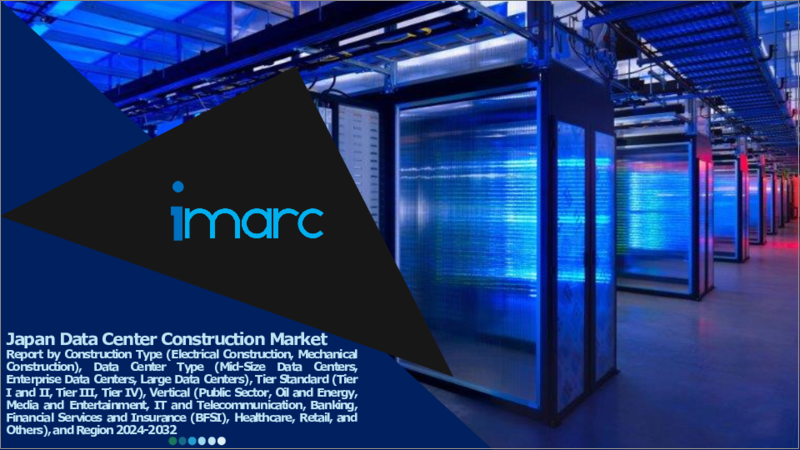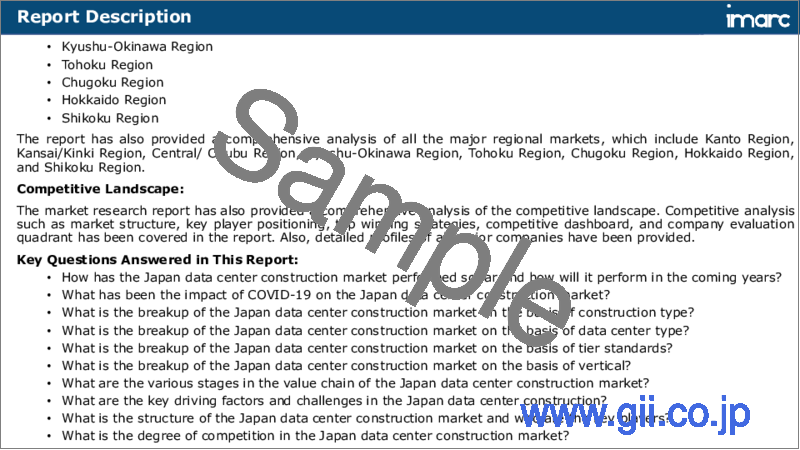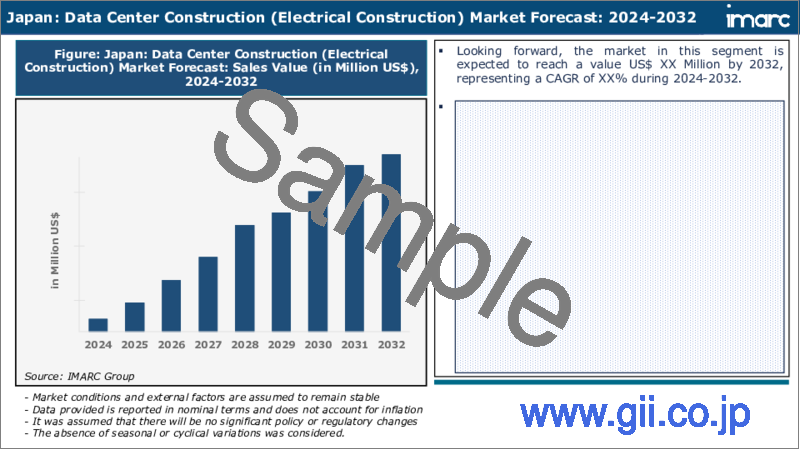|
|
市場調査レポート
商品コード
1609682
日本データセンター建設市場レポート:建設タイプ、データセンタータイプ、ティアスタンダード、業界別、地域別、2024年~2032年Japan Data Center Construction Market Report by Construction Type, Data Center Type, Tier Standard, Vertical, and Region 2024-2032 |
||||||
カスタマイズ可能
|
|||||||
| 日本データセンター建設市場レポート:建設タイプ、データセンタータイプ、ティアスタンダード、業界別、地域別、2024年~2032年 |
|
出版日: 2024年12月05日
発行: IMARC
ページ情報: 英文 116 Pages
納期: 5~7営業日
|
- 全表示
- 概要
- 目次
日本データセンター建設市場の市場規模は2023年に66億米ドルに達しました。今後、IMARC Groupは、同市場が2032年までに121億米ドルに達し、2024年から2032年の間に6.89%の成長率(CAGR)を示すと予測しています。同市場は、オンラインショッピングやeコマースプラットフォームへの依存度の高まり、モバイルバンキングアプリケーション(mバンキングアプリ)の採用急増、大量のデータを生成するモノのインターネット(IoT)デバイスの利用拡大など、いくつかの主要な要因により大きな成長を遂げています。
本レポートで扱う主な質問
- 日本データセンター建設市場のこれまでの業績と、今後数年間の業績は?
- COVID-19が日本データセンター建設市場に与えた影響は?
- 日本データセンター建設市場の建設タイプ別の内訳は?
- 日本データセンター建設市場のデータセンタータイプ別の内訳は?
- 日本データセンター建設市場の階層別内訳を教えてください。
- 日本データセンター建設市場の階層別の内訳は?
- 日本データセンター建設市場のバリューチェーンにはどのような段階がありますか?
- 日本のデータセンター建設における主な促進要因と課題は何か?
- 日本データセンター建設市場の構造と主要プレーヤーは?
- 日本データセンター建設市場における競合の程度は?
目次
第1章 序文
第2章 調査範囲と調査手法
- 調査の目的
- ステークホルダー
- データソース
- 市場推定
- 調査手法
第3章 エグゼクティブサマリー
第4章 日本データセンター建設市場-イントロダクション
- 概要
- 市場力学
- 業界動向
- 競合情報
第5章 日本データセンター建設市場情勢
- 過去および現在の市場動向(2018~2023年)
- 市場予測(2024~2032年)
第6章 日本データセンター建設市場- 建設タイプ別の内訳
- 電気工事
- 機械構造
第7章 日本データセンター建設市場- データセンタータイプ別の内訳
- 中規模データセンター
- エンタープライズデータセンター
- 大規模データセンター
第8章 日本データセンター建設市場- ティアスタンダード別内訳
- ティアIとII
- ティアIII
- ティアIV
第9章 日本データセンター建設市場-業界別の内訳
- 公共部門
- 石油とエネルギー
- メディアとエンターテイメント
- IT・通信
- 銀行、金融サービス、保険(BFSI)
- ヘルスケア
- 小売り
- その他
第10章 日本データセンター建設市場-競合情勢
- 概要
- 市場構造
- 市場プレーヤーのポジショニング
- 主要成功戦略
- 競合ダッシュボード
- 企業評価象限
第11章 主要企業のプロファイル
第12章 日本データセンター建設市場- 業界分析
- 促進要因・抑制要因・機会
- ポーターのファイブフォース分析
- バリューチェーン分析
第13章 付録
Japan data center construction market size reached US$ 6.6 Billion in 2023. Looking forward, IMARC Group expects the market to reach US$ 12.1 Billion by 2032, exhibiting a growth rate (CAGR) of 6.89% during 2024-2032. The market is witnessing significant growth due to several key factors, including the increasing dependence on online shopping and e-commerce platforms, a surge in the adoption of mobile banking applications (m-banking apps), and the expanding utilization of Internet of Things (IoT) devices that generate substantial volumes of data.
Data center construction entails the procedures involved in constructing and establishing a facility intended for the accommodation and supervision of an organization's computer systems, networking apparatus, and related components. This process demands meticulous planning and precise execution to guarantee that the facility fulfills particular prerequisites, including security measures, power availability, cooling systems, and redundancy strategies. The primary purpose of data center construction is to facilitate the storage, processing, and efficient management of extensive volumes of data. It results in the creation of a stable, secure, and highly efficient environment where servers and other hardware components can function optimally throughout the entire day.
Japan Data Center Construction Market Trends:
The growth of the data center construction market in Japan is being significantly bolstered by various factors. Firstly, there is a mounting reliance on e-commerce platforms that demand robust data storage and processing capabilities to support their operations effectively. Secondly, there is a rising adoption of data center facilities within the banking, financial services, and insurance (BFSI) sector. These facilities are employed to streamline banking operations and enhance the user experience, contributing to market expansion. Furthermore, the increased use of mobile banking applications (m-banking apps) is being driven by rapid digitization and a substantial dependence on smartphones. This trend is positively impacting the market. Additionally, the growing utilization of Internet of Things (IoT) devices, which generate substantial volumes of data, is creating a favorable market outlook. Moreover, the healthcare industry is increasingly adopting data center construction for the recording and maintenance of patient data, further driving market growth.
The exponential rise in global data consumption, coupled with the proliferation of digital technologies like IoT devices, smartphones, and cloud computing, has increased data storage requirements worldwide. As organizations implement digital transformation strategies, there is a growing need for high-capacity and reliable data centers. This surge in demand has led both public and private organizations to invest in expanding existing data centers or constructing new facilities, which is expected to propel the regional market in the coming years.
Japan Data Center Construction Market Segmentation:
Construction Type Insights:
- Electrical Construction
- Mechanical Construction
Data Center Type Insights:
- Mid-Size Data Centers
- Enterprise Data Centers
- Large Data Centers
Tier Standards Insights:
- Tier I and II
- Tier III
- Tier IV
Vertical Insights:
- Public Sector
- Oil and Energy
- Media and Entertainment
- IT and Telecommunication
- Banking, Financial Services and Insurance (BFSI)
- Healthcare
- Retail
- Others
Competitive Landscape:
The market research report has also provided a comprehensive analysis of the competitive landscape. Competitive analysis such as market structure, key player positioning, top winning strategies, competitive dashboard, and company evaluation quadrant has been covered in the report. Also, detailed profiles of all major companies have been provided.
Key Questions Answered in This Report:
- How has the Japan data center construction market performed so far and how will it perform in the coming years?
- What has been the impact of COVID-19 on the Japan data center construction market?
- What is the breakup of the Japan data center construction market on the basis of construction type?
- What is the breakup of the Japan data center construction market on the basis of data center type?
- What is the breakup of the Japan data center construction market on the basis of tier standards?
- What is the breakup of the Japan data center construction market on the basis of vertical?
- What are the various stages in the value chain of the Japan data center construction market?
- What are the key driving factors and challenges in the Japan data center construction?
- What is the structure of the Japan data center construction market and who are the key players?
- What is the degree of competition in the Japan data center construction market?
Table of Contents
1 Preface
2 Scope and Methodology
- 2.1 Objectives of the Study
- 2.2 Stakeholders
- 2.3 Data Sources
- 2.3.1 Primary Sources
- 2.3.2 Secondary Sources
- 2.4 Market Estimation
- 2.4.1 Bottom-Up Approach
- 2.4.2 Top-Down Approach
- 2.5 Forecasting Methodology
3 Executive Summary
4 Japan Data Center Construction Market - Introduction
- 4.1 Overview
- 4.2 Market Dynamics
- 4.3 Industry Trends
- 4.4 Competitive Intelligence
5 Japan Data Center Construction Market Landscape
- 5.1 Historical and Current Market Trends (2018-2023)
- 5.2 Market Forecast (2024-2032)
6 Japan Data Center Construction Market - Breakup by Construction Type
- 6.1 Electrical Construction
- 6.1.1 Overview
- 6.1.2 Historical and Current Market Trends (2018-2023)
- 6.1.3 Market Forecast (2024-2032)
- 6.2 Mechanical Construction
- 6.2.1 Overview
- 6.2.2 Historical and Current Market Trends (2018-2023)
- 6.2.3 Market Forecast (2024-2032)
7 Japan Data Center Construction Market - Breakup by Data Center Type
- 7.1 Mid-Size Data Centers
- 7.1.1 Overview
- 7.1.2 Historical and Current Market Trends (2018-2023)
- 7.1.3 Market Forecast (2024-2032)
- 7.2 Enterprise Data Centers
- 7.2.1 Overview
- 7.2.2 Historical and Current Market Trends (2018-2023)
- 7.2.3 Market Forecast (2024-2032)
- 7.3 Large Data Centers
- 7.3.1 Overview
- 7.3.2 Historical and Current Market Trends (2018-2023)
- 7.3.3 Market Forecast (2024-2032)
8 Japan Data Center Construction Market - Breakup by Tier Standards
- 8.1 Tier I and II
- 8.1.1 Overview
- 8.1.2 Historical and Current Market Trends (2018-2023)
- 8.1.3 Market Forecast (2024-2032)
- 8.2 Tier III
- 8.2.1 Overview
- 8.2.2 Historical and Current Market Trends (2018-2023)
- 8.2.3 Market Forecast (2024-2032)
- 8.3 Tier IV
- 8.3.1 Overview
- 8.3.2 Historical and Current Market Trends (2018-2023)
- 8.3.3 Market Forecast (2024-2032)
9 Japan Data Center Construction Market - Breakup by Vertical
- 9.1 Public Sector
- 9.1.1 Overview
- 9.1.2 Historical and Current Market Trends (2018-2023)
- 9.1.3 Market Forecast (2024-2032)
- 9.2 Oil and Energy
- 9.2.1 Overview
- 9.2.2 Historical and Current Market Trends (2018-2023)
- 9.2.3 Market Forecast (2024-2032)
- 9.3 Media and Entertainment
- 9.3.1 Overview
- 9.3.2 Historical and Current Market Trends (2018-2023)
- 9.3.3 Market Forecast (2024-2032)
- 9.4 IT and Telecommunication
- 9.4.1 Overview
- 9.4.2 Historical and Current Market Trends (2018-2023)
- 9.4.3 Market Forecast (2024-2032)
- 9.5 Banking, Financial Services and Insurance (BFSI)
- 9.5.1 Overview
- 9.5.2 Historical and Current Market Trends (2018-2023)
- 9.5.3 Market Forecast (2024-2032)
- 9.6 Healthcare
- 9.6.1 Overview
- 9.6.2 Historical and Current Market Trends (2018-2023)
- 9.6.3 Market Forecast (2024-2032)
- 9.7 Retail
- 9.7.1 Overview
- 9.7.2 Historical and Current Market Trends (2018-2023)
- 9.7.3 Market Forecast (2024-2032)
- 9.8 Others
- 9.8.1 Historical and Current Market Trends (2018-2023)
- 9.8.2 Market Forecast (2024-2032)
10 Japan Data Center Construction Market - Competitive Landscape
- 10.1 Overview
- 10.2 Market Structure
- 10.3 Market Player Positioning
- 10.4 Top Winning Strategies
- 10.5 Competitive Dashboard
- 10.6 Company Evaluation Quadrant
11 Profiles of Key Players
- 11.1 Company A
- 11.1.1 Business Overview
- 11.1.2 Product Portfolio
- 11.1.3 Business Strategies
- 11.1.4 SWOT Analysis
- 11.1.5 Major News and Events
- 11.2 Company B
- 11.2.1 Business Overview
- 11.2.2 Product Portfolio
- 11.2.3 Business Strategies
- 11.2.4 SWOT Analysis
- 11.2.5 Major News and Events
- 11.3 Company C
- 11.3.1 Business Overview
- 11.3.2 Product Portfolio
- 11.3.3 Business Strategies
- 11.3.4 SWOT Analysis
- 11.3.5 Major News and Events
- 11.4 Company D
- 11.4.1 Business Overview
- 11.4.2 Product Portfolio
- 11.4.3 Business Strategies
- 11.4.4 SWOT Analysis
- 11.4.5 Major News and Events
- 11.5 Company E
- 11.5.1 Business Overview
- 11.5.2 Product Portfolio
- 11.5.3 Business Strategies
- 11.5.4 SWOT Analysis
- 11.5.5 Major News and Events
12 Japan Data Center Construction Market - Industry Analysis
- 12.1 Drivers, Restraints, and Opportunities
- 12.1.1 Overview
- 12.1.2 Drivers
- 12.1.3 Restraints
- 12.1.4 Opportunities
- 12.2 Porters Five Forces Analysis
- 12.2.1 Overview
- 12.2.2 Bargaining Power of Buyers
- 12.2.3 Bargaining Power of Suppliers
- 12.2.4 Degree of Competition
- 12.2.5 Threat of New Entrants
- 12.2.6 Threat of Substitutes
- 12.3 Value Chain Analysis





